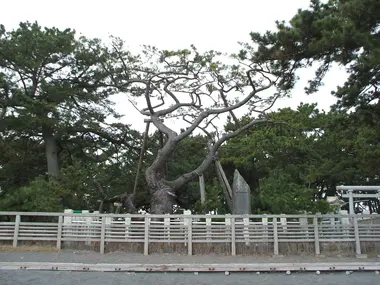5 places from Japanese legends to visit

Momotaro and his friends in Okayama
Flick/ jpellgen (@1179_jp)
In the heart of the Japan of tales and legends
Whether they tell us about local beliefs or how native people think, legends are a good way to discover a country's culture. But tales also turn out to be fantastic travel guides when you want to get off the beaten track! In order to discover the archipelago differently, Vivrele Japon presents 5 places tinged with mystery that will plunge you into the heart of Japanese legends.
TOHOKU
- Tono Town and Fukusenji Temple (Iwate Prefecture)
The kappa is certainly one of the best known yokai in Japan. Living in water, this little spirit has given rise to many legends, especially through the writings of the folklorist Kunio Yanagita who published in 1912 "Stories of Tono" , a collection of legends which is today one of the major works of Japanese folklore.
In love with the prefecture of Iwate, the writer brings together the urban legends he collected for several years in the town of Tono , a small town in the region which is said to be the place of unexplained phenomena . Among them, kappa stories are legion!
Small cucumber-loving sea monsters, the kappa are said to have made their home in the waters of Tono, which is still nicknamed “the town of folklore” today. And especially in the basin of the Fukusenji temple, the largest temple in the city!
See: The Kappa
Today, nothing says if these little spirits still live there, but the place remains a major tourist attraction in the region for all lovers of paranormal phenomena.
Useful information
Address: Matsuzaki-cho Komagi, Tono-shi, Iwate-ken
Opening hours: 8:00 a.m. to 5:00 p.m., closed from January to March
Price: adult 300 yen (2.30 euros), child 200 yen (1.50 euros)
Access: 15 minutes by car from Tono station

Fukusenji Temple
Flick/ view
- Mount Osore (Aomori prefecture)
According to a Buddhist legend, the souls of children are sent to the in-between world after death , a kind of limbo similar to those of the Catholic religion in which souls are taken before they can reach the afterlife.
To be admitted to the “Other side”, the children must then build mountains of stone under the protection of the deity Jizô who prevents evil spirits from disturbing the work of the little souls.
Among its border gates between the world of the living and that of the spirits , the summit of Mount Osore!
With its hot springs, gravel paths and smoky clouds, Mount Osore is reputed to be home to the Sanzu no K awa , “the river of three paths” that the souls of the deceased would cross before being able to reach the “Other world”.
It is also in this mystical place that the limbo intended to welcome the souls of children would be located.
This is why many small Jizô statues were placed along the roads of the mountain to guide the souls who would begin the ascent of the mountain.
So you are never quite alone on the paths of Mount Osore !
Useful information
Address: Usoriyama 3-2, Tanabe, Mutsu, Aomori Prefecture
Opening hours: May 1 to October 31, 6 a.m. to 6 p.m.
Price: 500 yen (3.85 euros)
Access: 45 minutes by bus from Shimokita station (Ominato line)
CHUBU
- Miho Pine (Shizuoka Prefecture)
Miho Pine is located on the beach that bears the same name, in Shizuoka Prefecture, just a few kilometers from Mount Fuji .
To go further: Myths and legends of Japanese beaches
Famous for being the subject of a tale, "the legend of Hagoromo" , the pine is today renowned for its good luck virtues.
Literally "feather coat" , the Hagoromo would have been worn by an angel who came to enjoy the waters of Miho . While proudly clinging to a pine tree while its owner bathed, the Hagoromo was stolen by a fisherman . Since the angel could not return home without his coat, he was forced to perform a celestial dance to recover his property. At the end of the tale, the angel ends up returning to heaven under the still dazzled eyes of the sinner.
This legend has become a classic and is today one of the major works of Noh theatre . This is why every October , a performance of the play is given on the beach during the Noh festival, very close to the altar which surrounds the pine on which the angel's garment would have been placed. A lovely show that brings the legend of the Hagoromo to life every year.
See also : Miho beach
Useful information
Address: MihoShimizu-ku, Shizuoka, 424-0901
Hours: all year
Price: free
Access: a few minutes by bus from Shimizu station (Tokaido line), Hagoromo-no-mastu stop.
CHUGOKU
- Okayama Prefecture and Megijima Island (Kagawa Prefecture)
A little boy found in a fishery by a river in Okayama, Momotaro is one of the most famous legendary heroes of the archipelago. Known to have driven out demons from the island of Megijima , the little man is still very popular today with the inhabitants of the island and the neighboring prefecture where he is said to have originated.
Between the caves of the island where the demons would have lived, the Okayama river where Momotaro would have been found, and the various tributes paid to the hero everywhere in these two places, the island of Megijima and the city of Okayama are certainly places to visit if you are fond of Herculean legends revisited with Japanese sauce.
To read :5 famous Japanese legends
Useful information
Access to Megijima Island: 20 minutes by boat from Takamatsu station (Yosan line)

Megijima Port is still home to a demon
Flick/ YELLOW Mao
KYUSHU
- Takachiho Gorge (Miyazaki Prefecture)
In addition to being recognized for their clear water and breathtaking landscapes, the Takachiho Gorge is said to house the cave where the goddess Amaterasu is said to have hidden after arguing with her brother Susanoo.
The act of rebellion of the goddess of the sun would then have caused an infinite night on the Earth , which only ceased when the latter was extricated from her hiding place by other divinities!
Discover Takachiho
Although Amaterasu has now returned to the heavens, the cave is still visible on the heights of Kyushu . And it is in the middle of the forest, behind the waterfalls of the surrounding river, that a small torii marks the entrance to the cave.
It should also be noted that the place hosts sacred dances called “ kagura ” every evening . This dance would have been used as a subterfuge to bring the goddess out of the cave.
Read: Takachiho Shrine and Kagura Dance
Useful information
Address: Mukoyama,Takachiho, Nishiusuki District, Miyazaki prefecture 882-1103
Hours: all year
Price: free
Access: 1h20 by bus from Nobeoka delagare (Nippo line)

Ema in an Amaterasu sanctuary
Flick/ jmurawski


















